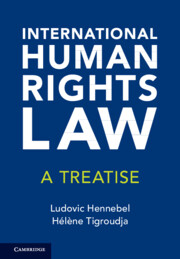Book contents
- International Human Rights Law
- International Human Rights Law
- Copyright page
- Dedication
- Contents
- About the Authors
- Acknowledgments
- Note on the Text
- Table of Cases
- Abbreviations
- Part I Foundations of International Human Rights Law
- Title 1 Theoretical Elements of International Human Rights Law
- 1 The Elusive Theory of Human Rights
- 2 The Idea of Human Rights
- 3 Exploring the Elusive Foundations of Human Rights
- 4 The Pragmatic Approach of International Human Rights Law
- Title 2 Normative Pluralism in International Human Rights Law
- Title 3 The Relationship Between International Human Rights Law and Other Branches of International Law
- Part II The Machinery of International Human Rights Law
- Part III The Interpretation of International Human Rights Law
- Part IV Remedies and Implementation of International Human Rights Decisions
4 - The Pragmatic Approach of International Human Rights Law
from Title 1 - Theoretical Elements of International Human Rights Law
Published online by Cambridge University Press: 10 April 2025
- International Human Rights Law
- International Human Rights Law
- Copyright page
- Dedication
- Contents
- About the Authors
- Acknowledgments
- Note on the Text
- Table of Cases
- Abbreviations
- Part I Foundations of International Human Rights Law
- Title 1 Theoretical Elements of International Human Rights Law
- 1 The Elusive Theory of Human Rights
- 2 The Idea of Human Rights
- 3 Exploring the Elusive Foundations of Human Rights
- 4 The Pragmatic Approach of International Human Rights Law
- Title 2 Normative Pluralism in International Human Rights Law
- Title 3 The Relationship Between International Human Rights Law and Other Branches of International Law
- Part II The Machinery of International Human Rights Law
- Part III The Interpretation of International Human Rights Law
- Part IV Remedies and Implementation of International Human Rights Decisions
Summary
A pragmatic approach to international human rights law involves discussing its premises, principles like human dignity, liberty, equality, and solidarity, and structural principles such as democracy, pluralism, and the rule of law. The chapter also examines the conditions, matters, and actors involved in the discussion. It explores how these principles are applied in practice and the challenges faced in their implementation. The chapter emphasizes the importance of a pragmatic approach that considers the practical realities of applying human rights principles in different contexts. It also discusses the role of various actors, including states, international organizations, and civil society, in promoting and protecting human rights.
Keywords
- Type
- Chapter
- Information
- International Human Rights LawA Treatise, pp. 27 - 40Publisher: Cambridge University PressPrint publication year: 2025

